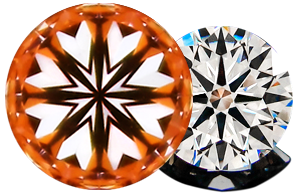
Should I use a Diamonds Proportions Calculator?
“I’m shopping for a diamond engagement ring and a friend suggested that I use an online diamond proportions calculator to ensure I buy a diamond with the best light performance. I found three different diamond proportions calculators online, and get slightly different results and evaluations on the same Brian Gavin Signature round diamond from each of them. I actually ended up running several BGD Signature diamonds through the diamond proportions calculators, the scoring seemed to be pretty consistent. Which makes me wonder, do I even need to rely upon a diamond proportions calculator when buying from Brian Gavin?”
Diamond Proportions vs Light Performance:
Diamond proportions certainly are a determining factor of the volume of light return that a diamond is going to exhibit, however it is only one piece of the puzzle. Those proportions calculators are based upon the results of studies that used mathematical ray tracing to model diamonds of different proportions.
While we can use the proportions of a round brilliant cut diamond to estimate the potential light return of a diamond, additional insight is required to accurately assess the light return due to differences in the degree of optical precision. Another issue is the manner in which different gemological laboratories round off the measurements stated on the diamond grading reports.
Fuzzy Data Goes In ≠ Fuzzy Output:
Brian Gavin Diamonds relies upon the expertise of the American Gem Society Laboratory (AGSL) because they use Angular Spectrum Evaluation Technology (ASET) to determine the light performance of a diamond. But we also prefer the AGSL because they don’t round off the measurements for table diameter, crown angle, crown height, pavilion depth, lower girdle facet length, or star facet length, all of which are rounded off (after being averaged) by the GIA and many other gemological laboratories.
Rounding off the components that comprise the overall proportions of a diamond after averaging them by section amounts to what we like to refer to as fuzzy math. Let’s say that a diamond has a crown angle of 34.8 degrees, the GIA is going to round that off to 35 degrees on the diamond grading report. And let’s say that it’s got a pavilion depth of 43.3 percent, the GIA is going to round that off to 43.5%. If the lower girdle facet length is 78% then the GIA is going to round that off to 80% but that might not matter for this particular example, because most diamond proportions calculators don’t take lower girdle facet length or star facet length into account.
Remember the Golden Rule of Computation: Garbage In = Garbage Out. Incorrect, faulty, or poor quality input will not produce the desired results.
Judging Optical Precision for Light Performance:
The best way to ensure that the diamond you purchase is going to exhibit the highest volume of light return and exhibit the best light performance, is to rely upon a combination of factors. Feel free to use diamond proportions calculators as “diamond elimination tools” which serve to eliminate diamonds with less desirable proportions, which are not likely to yield the best light return. This really is an unnecessary step with Brian Gavin Signature round diamonds, since they’re all cut to proportions that represent the middle of the spectrum designated for the zero ideal cut proportions rating.
 The next thing you’ll want to do is evaluate the degree of optical precision exhibited by the diamond using reflector scopes designed for that purpose. We use the ASET Scope to determine how bright a diamond is going to be, and how effectively it is gathering and reflecting the light that it is exposed to. We use Hearts & Arrows scopes to judge the consistency of facet shape, size, and alignment.
The next thing you’ll want to do is evaluate the degree of optical precision exhibited by the diamond using reflector scopes designed for that purpose. We use the ASET Scope to determine how bright a diamond is going to be, and how effectively it is gathering and reflecting the light that it is exposed to. We use Hearts & Arrows scopes to judge the consistency of facet shape, size, and alignment.
A crisp and complete pattern of hearts and arrows is an indication of the highest degree of optical precision. Diamonds that exhibit broken hearts that vary in size and shape are not “Hearts and Arrows diamonds” because the optical precision is not exceptional.
We also use the Ideal Scope to determine the degree of light leakage that a diamond exhibits. All diamonds are going to leak light to some degree, however super ideal cut diamonds offer the highest volume of light return. The pattern of light reflecting throughout the diamond should be evenly dispersed, there should not be erratic patterns of leakage, or extensive leakage in any section. Brian Gavin Diamonds provides these images for all Brian Gavin Signature round diamonds, as well as ASET and Ideal Scope images for Brian Gavin Blue fluorescent diamonds.
















